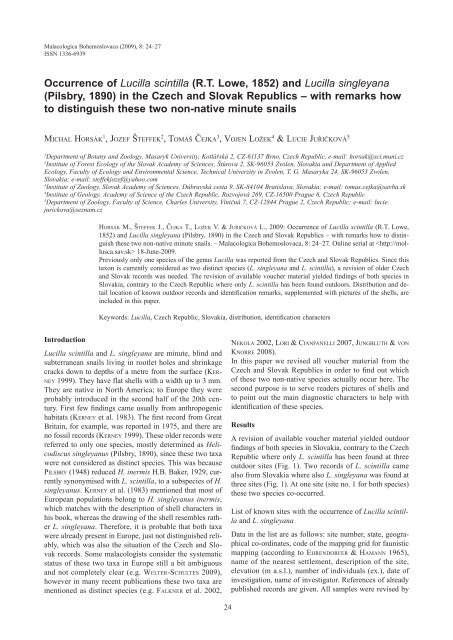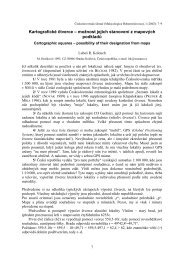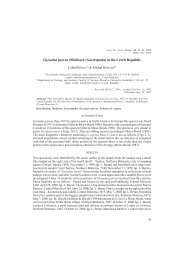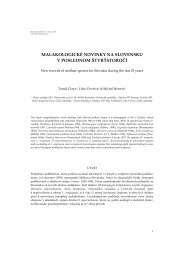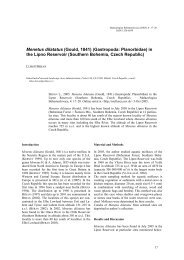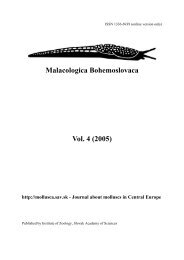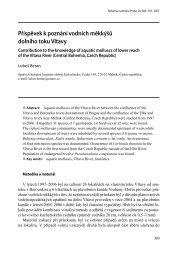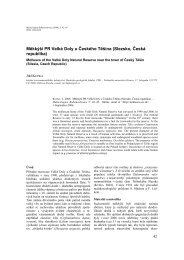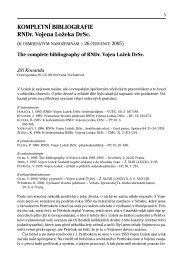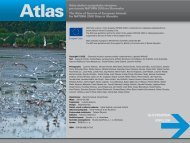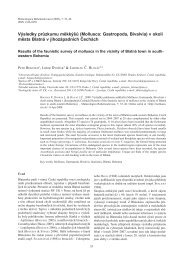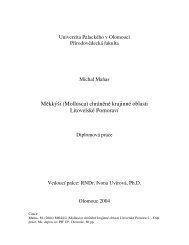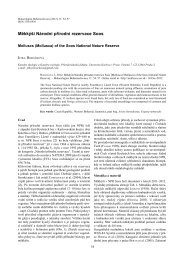Occurrence of Lucilla scintilla (RT Lowe, 1852) - Malacologica ...
Occurrence of Lucilla scintilla (RT Lowe, 1852) - Malacologica ...
Occurrence of Lucilla scintilla (RT Lowe, 1852) - Malacologica ...
Create successful ePaper yourself
Turn your PDF publications into a flip-book with our unique Google optimized e-Paper software.
<strong>Malacologica</strong> Bohemoslovaca (2009), 8: 24–27<br />
ISSN 1336-6939<br />
<strong>Occurrence</strong> <strong>of</strong> <strong>Lucilla</strong> <strong>scintilla</strong> (R.T. <strong>Lowe</strong>, <strong>1852</strong>) and <strong>Lucilla</strong> singleyana<br />
(Pilsbry, 1890) in the Czech and Slovak Republics – with remarks how<br />
to distinguish these two non-native minute snails<br />
MICHAL HORSÁK 1 , JOZEF ŠTEFFEK 2 , TOMÁŠ ČEJKA 3 , VOJEN LOŽEK 4 & LUCIE JUŘIČKOVÁ 5<br />
1<br />
Department <strong>of</strong> Botany and Zoology, Masaryk University, Kotlářská 2, CZ-61137 Brno, Czech Republic, e-mail: horsak@sci.muni.cz<br />
2<br />
Institute <strong>of</strong> Forest Ecology <strong>of</strong> the Slovak Academy <strong>of</strong> Sciences, Štúrova 2, SK-96053 Zvolen, Slovakia and Department <strong>of</strong> Applied<br />
Ecology, Faculty <strong>of</strong> Ecology and Environmental Science, Technical Univerzity in Zvolen, T. G. Masaryka 24, SK-96053 Zvolen,<br />
Slovakia; e-mail: steffekjozef@yahoo.com<br />
3<br />
Institute <strong>of</strong> Zoology, Slovak Academy <strong>of</strong> Sciences, Dúbravská cesta 9, SK-84104 Bratislava, Slovakia; e-mail: tomas.cejka@savba.sk<br />
4<br />
Institute <strong>of</strong> Geology, Academy <strong>of</strong> Science <strong>of</strong> the Czech Republic, Rozvojová 269, CZ-16500 Prague 6, Czech Republic<br />
5<br />
Department <strong>of</strong> Zoology, Faculty <strong>of</strong> Science, Charles University, Viničná 7, CZ-12844 Prague 2, Czech Republic; e-mail: lucie.<br />
jurickova@seznam.cz<br />
HORSÁK M., ŠTEFFEK J., ČEJKA T., LOŽEK V. & JUŘIČKOVÁ L., 2009: <strong>Occurrence</strong> <strong>of</strong> <strong>Lucilla</strong> <strong>scintilla</strong> (R.T. <strong>Lowe</strong>,<br />
<strong>1852</strong>) and <strong>Lucilla</strong> singleyana (Pilsbry, 1890) in the Czech and Slovak Republics – with remarks how to distinguish<br />
these two non-native minute snails. – <strong>Malacologica</strong> Bohemoslovaca, 8: 24–27. Online serial at <br />
18-June-2009.<br />
Previously only one species <strong>of</strong> the genus <strong>Lucilla</strong> was reported from the Czech and Slovak Republics. Since this<br />
taxon is currently considered as two distinct species (L. singleyana and L. <strong>scintilla</strong>), a revision <strong>of</strong> older Czech<br />
and Slovak records was needed. The revision <strong>of</strong> available voucher material yielded findings <strong>of</strong> both species in<br />
Slovakia, contrary to the Czech Republic where only L. <strong>scintilla</strong> has been found outdoors. Distribution and detail<br />
location <strong>of</strong> known outdoor records and identification remarks, supplemented with pictures <strong>of</strong> the shells, are<br />
included in this paper.<br />
Keywords: <strong>Lucilla</strong>, Czech Republic, Slovakia, distribution, identification characters<br />
Introduction<br />
<strong>Lucilla</strong> <strong>scintilla</strong> and L. singleyana are minute, blind and<br />
subterranean snails living in rootlet holes and shrinkage<br />
cracks down to depths <strong>of</strong> a metre from the surface (KER-<br />
NEY 1999). They have flat shells with a width up to 3 mm.<br />
They are native in North America; to Europe they were<br />
probably introduced in the second half <strong>of</strong> the 20th century.<br />
First few findings came usually from anthropogenic<br />
habitats (KERNEY et al. 1983). The first record from Great<br />
Britain, for example, was reported in 1975, and there are<br />
no fossil records (KERNEY 1999). These older records were<br />
referred to only one species, mostly determined as Helicodiscus<br />
singleyanus (Pilsbry, 1890), since these two taxa<br />
were not considered as distinct species. This was because<br />
PILSBRY (1948) reduced H. inermis H.B. Baker, 1929, currently<br />
synonymised with L. <strong>scintilla</strong>, to a subspecies <strong>of</strong> H.<br />
singleyanus. KERNEY et al. (1983) mentioned that most <strong>of</strong><br />
European populations belong to H. singleyanus inermis,<br />
which matches with the description <strong>of</strong> shell characters in<br />
his book, whereas the drawing <strong>of</strong> the shell resembles rather<br />
L. singleyana. Therefore, it is probable that both taxa<br />
were already present in Europe, just not distinguished reliably,<br />
which was also the situation <strong>of</strong> the Czech and Slovak<br />
records. Some malacologists consider the systematic<br />
status <strong>of</strong> these two taxa in Europe still a bit ambiguous<br />
and not completely clear (e.g. WELTER-SCHULTES 2009),<br />
however in many recent publications these two taxa are<br />
mentioned as distinct species (e.g. FALKNER et al. 2002,<br />
NEKOLA 2002, LORI & CIANFANELLI 2007, JUNGBLUTH & VON<br />
KNORRE 2008).<br />
In this paper we revised all voucher material from the<br />
Czech and Slovak Republics in order to find out which<br />
<strong>of</strong> these two non-native species actually occur here. The<br />
second purpose is to serve readers pictures <strong>of</strong> shells and<br />
to point out the main diagnostic characters to help with<br />
identification <strong>of</strong> these species.<br />
Results<br />
A revision <strong>of</strong> available voucher material yielded outdoor<br />
findings <strong>of</strong> both species in Slovakia, contrary to the Czech<br />
Republic where only L. <strong>scintilla</strong> has been found at three<br />
outdoor sites (Fig. 1). Two records <strong>of</strong> L. <strong>scintilla</strong> came<br />
also from Slovakia where also L. singleyana was found at<br />
three sites (Fig. 1). At one site (site no. 1 for both species)<br />
these two species co-occurred.<br />
List <strong>of</strong> known sites with the occurrence <strong>of</strong> <strong>Lucilla</strong> <strong>scintilla</strong><br />
and L. singleyana<br />
Data in the list are as follows: site number, state, geographical<br />
co-ordinates, code <strong>of</strong> the mapping grid for faunistic<br />
mapping (according to EHRENDORFER & HAMANN 1965),<br />
name <strong>of</strong> the nearest settlement, description <strong>of</strong> the site,<br />
elevation (m a.s.l.), number <strong>of</strong> individuals (ex.), date <strong>of</strong><br />
investigation, name <strong>of</strong> investigator. References <strong>of</strong> already<br />
published records are given. All samples were revised by<br />
24
Fig. 1. Known outside records <strong>of</strong> <strong>Lucilla</strong> <strong>scintilla</strong> (empty dots) and L. singleyana (black dots) in the Czech and<br />
Slovak Republics. Co-occurrence <strong>of</strong> both species is marked by black square.<br />
M. Horsák except two records <strong>of</strong> V. Ložek. Voucher specimens<br />
are deposited in personal collections <strong>of</strong> particular<br />
investigators.<br />
<strong>Lucilla</strong> <strong>scintilla</strong><br />
1 – Slovakia, 48°08'23"N, 17°06'39"E, 7868, Bratislava,<br />
a flood debris <strong>of</strong> the Danube River, 135 m, 2 ex., 20<br />
Mar 1999, T. Čejka, originally published as Helicodiscus<br />
(Hebetodiscus) singleyanus inermis (ČEJKA 2000); 2<br />
– Slovakia, 48°31'39.44"N, 17°51'51.47"E, 7479, Sklené<br />
Teplice, a spa – a travertine below the church, 352 m, 1<br />
ex., 10 Jul 2007, J. Šteffek; 3 – Slovakia, 48°28'17.66"N,<br />
18°43'36.80"E, 7578, Žarnovica, a flood debris <strong>of</strong> the Hron<br />
River, 216 m, 2 ex., 11 Apr 1996, J. Šteffek, originally<br />
published as L. singleyana (ŠTEFFEK 2003); 4 – Czech Republic,<br />
Bohemia, 50°13'39"N, 15°50'40"E, 5761, Hradec<br />
Králové, Věkoše Cemetery, 235 m, 2 ex., 3 May 1999,<br />
2 ex., 8 May 2001, L. Juřičková, originally published as<br />
Helicodiscus inermis (JUŘIČKOVÁ 1998); 5 − Czech Republic,<br />
Bohemia, 50°31'06"N, 14°57'01"E, 5455, Mnichovo<br />
Hradiště, a flood debris <strong>of</strong> the Zábrtka stream, 245 m, 1<br />
ex., 1987, V. Ložek, originally published as Helicodiscus<br />
inermis (LOŽEK 1988); 6 − Czech Republic, Bohemia,<br />
48°51'10"N, 14°22'14"E, 7152, Zlatá Koruna, a food debris<br />
<strong>of</strong> the Vltava River, 480 m, 1 ex, 2006, V. Ložek.<br />
<strong>Lucilla</strong> singleyana<br />
1 – Slovakia, 48°08'23"N, 17°06'39"E, 7868, Bratislava,<br />
a flood debris <strong>of</strong> the Danube River, 135 m, 5 ex., 20 Mar<br />
1999, T. Čejka, originally published as Helicodiscus (Hebetodiscus)<br />
singleyanus inermis (ČEJKA 2000); 2 – Slovakia,<br />
48°15'32.27"N, 17°47'14.50"E, 7772, Kráľová pri<br />
Senci, a deposit <strong>of</strong> the reservoir, 123 m, 1 ex., 16 May<br />
2004, J. Šteffek & B. Bielčík; 3 – Slovakia, 48°45'19"N,<br />
19°16'19"E, 7281, Driekyňa stream, near Slovenská<br />
Ľupča, a deposit <strong>of</strong> the stream, 408 m, 1 ex., 8 Jun 2003,<br />
J. Šteffek.<br />
Identification remarks<br />
These two species are conchologically rather similar;<br />
however they bear many reliable and unequivocal characters.<br />
Most <strong>of</strong> these characters have been described already<br />
by PILSBRY (1948). They differ in shell size and shape, and<br />
especially in colour <strong>of</strong> periostracum (= conchyolin layer).<br />
The most prominent character is colour <strong>of</strong> periostracum<br />
(Figs 2–4): L. singleyana being uncoloured (Fig. 2) and L.<br />
<strong>scintilla</strong> being distinctly yellowish (Fig. 3). L. singleyana<br />
can grow up higher; shell width is up to 3 mm contrary to<br />
L. <strong>scintilla</strong> whose shell can only slightly exceeds 2 mm.<br />
This species has a slightly conical shell spire contrary to<br />
L. singleyana that has a completely flat spire. Additional<br />
characters are a bit more closed and deeper umbilicus <strong>of</strong> L.<br />
<strong>scintilla</strong> contrary to opened and shallower umbilicus <strong>of</strong> L.<br />
singleyana (cf. Figs 2 and 3). PILSBRY (1948) also thought<br />
<strong>of</strong> surface microsculpture as another difference between<br />
these species; in his conception subspecies. L. singleyana<br />
is under a higher magnification closely covered with<br />
microscopic spiral lines which are nearly or entirely missing<br />
in L. <strong>scintilla</strong>. However, in our material this character<br />
appeared to be hard to track and rather variable among<br />
specimens <strong>of</strong> both species. Since the interspecies variation<br />
<strong>of</strong> the surface microsculpture was one <strong>of</strong> the reasons why<br />
PILSBRY (1948) reduced these taxa to one species it is questionable<br />
if this is a good and useful character for reliable<br />
identification. Even though, our material was limited we<br />
recommend not using this character especially if there are<br />
several other more obvious and reliable differences.<br />
In the course <strong>of</strong> reviewing this paper we found out that<br />
several authors may have a problem with distinguishing<br />
snails <strong>of</strong> the genus <strong>Lucilla</strong> from those belonging to the<br />
genus Hawaiia. They used characters on male genitalia or<br />
on radula to distinguish between <strong>Lucilla</strong> spp. and Hawaiia<br />
minuscula (Binney, 1840) (e.g. DOMOKOS & MAJOROS<br />
2008). However, these species clearly differ in the shape<br />
<strong>of</strong> their shells and mainly in surface microstructures. <strong>Lucilla</strong><br />
spp. have a smooth shell surface only with very fine<br />
25
Fig. 2. Shell <strong>of</strong> <strong>Lucilla</strong> singleyana from site no. 1. Width: 2.3<br />
mm, high: 1.0 mm.<br />
Fig. 3. Shell <strong>of</strong> <strong>Lucilla</strong> <strong>scintilla</strong> from site no. 4. Width: 2.05 mm,<br />
high: 1.00 mm.<br />
spiral lines (mentioned above) and it is rather glossy. In<br />
contrast H. minuscula has nearly regular transversal striae<br />
crossed by prominent spiral striae and the surface is not<br />
glossy. These identification characters were for example<br />
mentioned by MÁCHA (1988) who also supplemented his<br />
paper by informative SEM photographs <strong>of</strong> shell surfaces;<br />
the same was published by LORI & CIANFANELLI (2007).<br />
Further, the entire shell <strong>of</strong> H. minuscula is more thick and<br />
with a significantly deeper suture. Finally, up till now H.<br />
minuscula has been reported in Europe only from greenhouses<br />
(KERNEY et al. 1983, HORSÁK et al. 2004).<br />
Discussion<br />
Sporadic records, mostly as empty shells sieved from the<br />
flood debris <strong>of</strong> rivers in Britain, were considered as results<br />
<strong>of</strong> cryptic life mode <strong>of</strong> these species (KERNEY 1999). A<br />
very similar situation was documented also based on our<br />
material. Almost all our shells were empty; however, they<br />
have an intact periostracum. These species are probably<br />
more common in both Czech Republic and Slovakia than<br />
one could expect solely based on known records. Several<br />
Czech and Slovak records have also origin in greenhouses<br />
as these snails are probably rather common there (e.g.<br />
FLASAR 1978, HORSÁK et al. 2004), but these findings were<br />
not revised and considered in this study. Here it is worth<br />
mentioning that L. singleyana has already been found in<br />
the Czech Republic in greenhouses <strong>of</strong> the Masaryk University<br />
in Brno (2004, M. Ruprechtová lgt., M. Horsák<br />
det.). Therefore it seems probable that this species is also<br />
living outside in the Czech Republic.<br />
26
Fig. 4. Direct comparison <strong>of</strong> shell size, shape and colour <strong>of</strong> <strong>Lucilla</strong> <strong>scintilla</strong> (a–b) and L. singleyana (c–e). Location: a, site no 4;<br />
b–e, site no. 1.<br />
Acknowledgements<br />
Funding comes from grants IAA601630803, MSM<br />
0021622416, MSM 0021620828, VEGA 1/7079/07, VEGA<br />
1/4353/07, VEGA 1/0026/08, and VEGA 2/0130/07.<br />
References<br />
ČEJKA T., 2000: First record <strong>of</strong> the land snail Helicodiscus (Hebetodiscus)<br />
singleyanus inermis H.B. Baker, 1929 (Gastropoda,<br />
Punctidae) in Slovakia. − Biologia (Bratislava), 55: 475−476.<br />
DOMOKOS T. & MAJOROS G., 2008: A <strong>Lucilla</strong> singleyana (Pilsbry,<br />
1889) (Gastropoda: Helicodiscidae) – „talajlakó laposcsigácska”<br />
– elöfordulása hazánkban, különös tekintettel a Körös–Maros<br />
közére (Magyarország és Románia) [The <strong>Occurrence</strong> <strong>of</strong> <strong>Lucilla</strong><br />
singleyana (Pilsbry, 1889) (Gastropoda: Helicodiscidae) in<br />
Hungary, and especially at the Kõrös-Maros interfluves in Hungary<br />
and Romania]. − <strong>Malacologica</strong>l Newsletter, 26: 19–32.<br />
EHRENDORFER F. & HAMANN U., 1965: Vorschläge zu einer floristischen<br />
Kartierung von Mitteleuropa. − Berichte der Deutschen<br />
Botanischen Gesellschaft, 78: 35−50.<br />
FALKNER G., RIPKEN T.E.J. & FALKNER M., 2002: Mollusques continentaux<br />
de France. Liste de Référence annotée et Bibliographie.<br />
− Patrimoines naturels, 52: 1−350.<br />
FLASAR I., 1978: Nový druh měkkýše v našich sklenících [New<br />
snail species in our greenhouses]. – Živa, 5/1978: 182.<br />
HORSÁK M., DVOŘÁK L. & JUŘIČKOVÁ L., 2004: Greenhouse<br />
gastropods <strong>of</strong> the Czech Republic: current stage <strong>of</strong> research.<br />
– <strong>Malacologica</strong>l Newsletter, 22: 141–147.<br />
JUNGBLUTH J.H. & KNORRE VON D., 2008: Trivialnamen der Landund<br />
Süßwassermollusken Deutschlands (Gastropoda et Bivalvia).<br />
– Mollusca, 26(1): 105–156.<br />
JUŘIČKOVÁ L., 1998: Měkkýši Hradce Králové [Mollusca <strong>of</strong> Hradec<br />
Králové, East Bohemia, Czech Republic]. − Acta Musei<br />
Reginaehradecensis s. A., 26: 101−172.<br />
27<br />
KERNEY M., 1999: Atlas <strong>of</strong> the land and freshwater molluscs <strong>of</strong><br />
Britain and Ireland. – Harley Books, Colchester, 261 pp.<br />
KERNEY M.P., CAMERON R.A.D. & JUNGBLUTH J.H., 1983: Die<br />
Landschnecken Nord- und Mitteleuropas. – Verlag Paul Parey,<br />
Hamburg und Berlin, 384 pp.<br />
LORI E. & CIANFANELLI S., 2007: Studio sulla presenza e distribuzione<br />
di Molluschi terrestri e d‘acqua dolce alieni nel territorio<br />
della provincia di Pistoia. Relazione finale per la Provincia<br />
di Pistoia, pp. 97. – Unpublished final report available at<br />
http://www.provincia.pistoia.it/AreeProtette/LR56_2000_Mol-<br />
luschiEduliCrostaceiAcquaDolce/MolluschiAlieniProvincia-<br />
Pistoia.pdf<br />
LOŽEK V., 1988: Měkkýši a změny prostředí [Molluscs and environmental<br />
changes]. − Památky a příroda, 13(9): 547−553.<br />
MÁCHA S., 1988: Další nový druh měkkýše v našich sklenících –<br />
Hawaia minuscula (Binney, 1840) sic! [Other new mollusc species<br />
in our greenhouses – Hawaia minuscula (Binney, 1840)].<br />
– Čas. Slez. Muz. Opava (A), 37: 63–64.<br />
NEKOLA J.C., 2002: Effects <strong>of</strong> fire management on the richness<br />
and abundance <strong>of</strong> central North American grassland land snail<br />
faunas. – Animal Biodiversity and Conservation, 25(2): 53–<br />
66.<br />
PILSBRY H.A., 1948: Land Mollusca <strong>of</strong> North America (north <strong>of</strong><br />
Mexico). Vol. II. Part II. − Academy <strong>of</strong> Natural Science <strong>of</strong> Philadelphia.<br />
Philadelphia, PA., 520 pp.<br />
ŠTEFFEK J., 2003: Význam náplavov pre výskum diverzity mäkkýšov<br />
na príklade rieky Hron v Žarnovici [Importance <strong>of</strong> flood<br />
debris for the research <strong>of</strong> mollusc diversity: a case study from<br />
the river <strong>of</strong> Hron near Žarnovice town]. − Acta Facultatis Ecologiae<br />
(Zvolen), 10, Suppl. 1: 213−215.<br />
WELTER-SCHULTES F., 2009: AnimalBase Project Group, 2005.<br />
AnimalBase. Early zoological literature online. Worldwide<br />
web electronic publication. − http://www.animalbase.uni-goettingen.de/zooweb/servlet/AnimalBase/home/speciesid=3162,<br />
last modification 26-02-2009.


